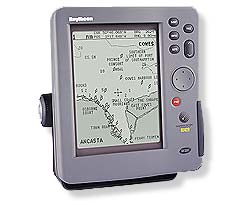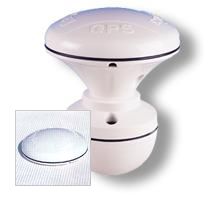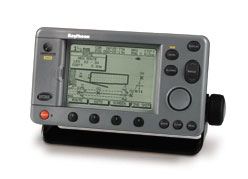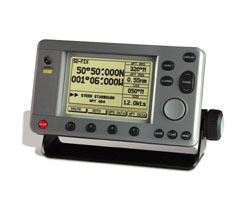
WAAS Up With GPS?
New Technology Stands For Better Accuracy At Less Cost
By Thom Burns
Just over a year ago Selective Availability (SA) finally ceased degrading the accuracy of signals from the Global Positioning System (GPS) satellites. It was hard to imagine that the system could get much better. A new system coming online from the Federal Aviation Administration (FAA) that was designed for airplane pilots will be a boon for recreational boaters. The Wide Area Augmentation System, or WAAS, is spawning a whole new generation of GPS receivers that are reportedly giving users as good as three-meter accuracy.
A Little History
The Global Positioning System (GPS) was strictly a military system at first. When it was released for civilian use, the Department of Defense, nervous about some bad guys using it to direct missiles at strategic targets, set up Selective Availability (SA) - an induced satellite-clock error that reduced positioning accuracy unless a special military-only receiver was used. The value of SA was hotly debated. The risks of relying upon an incorrect indicated position were severe enough that the Coast Guard developed an error-correction system called Differential GPS
(DGPS).
 |
DGPS corrected most of the induced time error and thus the positioning error. It did this with a fixed, land-based receiver at a known position which would correct for the errors introduced by SA at that location. The corrected information is then broadcast to GPS receivers situated reasonably close to the fixed receiver. Depending on exactly where you were the more accurate the corrections. The original government-sponsored differential correction scheme uses existing Coast Guard-operated radio beacon transmitters from the old Radio Direction Finder system. These transmitters are located throughout the country and operate in the 300 kHz range. This system works but has some problems.
The range is limited to about 100 miles off the coast. Since the signals used to transmit the differential corrections are radio waves, they are subject to interference from weather conditions, propagation problems and even other electronics aboard. It also necessitates an additional receiver and antenna which must be connected to a GPS unit which is built to accept these signals. This complicates installation and adds considerably to the cost. Most experts quote at least $300 for this part of the equipment plus installation.
 |
Despite its drawbacks the DGPS works. Position errors, even with SA in effect, were typically reduced from several hundred feet to about 30 feet.
The introduction of DGPS made the use of SA even more controversial. The Coast Guard set-up a system specifically to defeat SA. After a dozen or so years of complaints, President Clinton pulled the SA plug. Suddenly, the accuracy of all GPS receivers improved dramatically.
Accuracy between 15 and 30 feet is certainly good enough for most boaters. It is not good enough to land aircraft or to locate a narrow channel in pea soup fog. More demanding applications such as these require more accuracy.
Corrections
GPS is based on the ability of the satellites to know their own locations and your receiver’s capacity to maintain synchronization with the satellites. The satellites tell your receiver where they are in space. Your receiver calculates the time it takes for each satellite’s signal to reach it, and therefore can determine how far it is from each satellite. Three or more satellites, plus some math and you will know where you are.
 |
Errors occur because satellites do not always have predictable orbits; clocks are not completely accurate and signals from satellites can be subject to distortion caused by the atmosphere. These errors can be corrected. That’s where DGPS, and now WAAS, comes in.
WAAS uses Geosynchronous Earth Orbiting satellites. These GEO satellites are in lower orbit and remain in fixed positions relative to the earth. This is dramatically different from DGPS which uses the old land-based 300 kHz transmitting stations. The satellite system covers a much wider area than DGPS. The use of a very high frequency signal means less interference. It also eliminates the need for a separate antenna and receiver.
WAAS system receivers extract the data received from the GEO satellites and send it to a Wide Area Master Station (WMS). The WMS calculates the necessary correction data and checks for system irregularities. The correction message is then prepared at the WMS and sent to the
GEOs.
The resulting system is more accurate than DGPS and it covers a much wider geographical range. In fact the system may go almost worldwide because several European and Asian countries are now developing compatible systems.
 |
“The U.S. has very good coverage,” said Dan Bartel, head of recreational products for Garmin, which expects to have six more WAAS products available in May. “Regular GPS without WAAS should provide 10-meter accuracy. WAAS is designed to give you seven meters, but in our testing, we’re seeing three meters.
The people who will want this are fishermen and divers,” said Bartel of recreational users. “If you want to get back to a good fishing spot or an underwater wreck, this will put you right on top of it.”
Recommendations
Every indication is that WAAS works as advertised. It provides the best, repeatable accuracy. WAAS GPS receivers are less expensive than DGPS receivers and are easier to install. The tougher questions come when you compare your current DGPS unit to a new WAAS. Is the improvement in accuracy enough to justify scrapping your existing GPS receiver. My suggestion is that probably not.
If you already have a GPS or a handheld GPS without the differential feature, your choice is harder. Will that unit meet my accuracy needs? Is it still a viable unit? I own a Garmin GPS II which uses a little more battery power than I like. I’ve been playing with the handheld Garmin 76. If you are a current owner of a Garmin handheld, be aware that some of the user interfaces and software have changed. This is not a negative, but you will have to get used to the new unit’s look and feel. At a base price of $219, this is competitive with anything out there. I will probably change within the year. It could be an excellent buy depending on your individual circumstances.
The easiest question of all is if you do not own a GPS or a DGPS. It seems like a no brainer to buy the WAAS unit over the DGPS. So much so that I predict the DGPS will be out of production within the year. If you are in the market and do not own a GPS, the evidence seems just about as strong to get the WAAS.
Excitement Coming?
You can already get chart downloads for these GPSs. The handheld Garmin comes with a Tides and Currents feature. Soon the these units may be pointing to Navigational Aids and at some point even depth adjusted according to the Tide Tables already included.
The demise of Selective Availability made all GPS receivers pretty good. The WAAS system is and will continue to revolutionize the GPS market. It’s about time something exciting happened in marine electronics.
Thom Burns publishes Northern Breezes and teaches navigation.